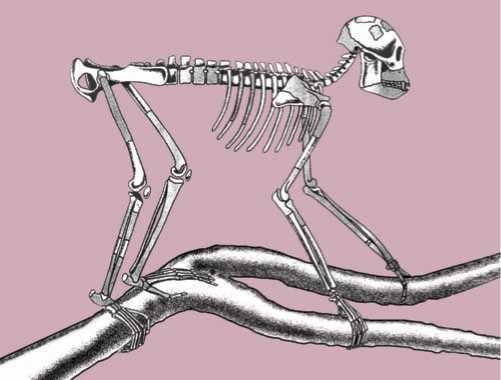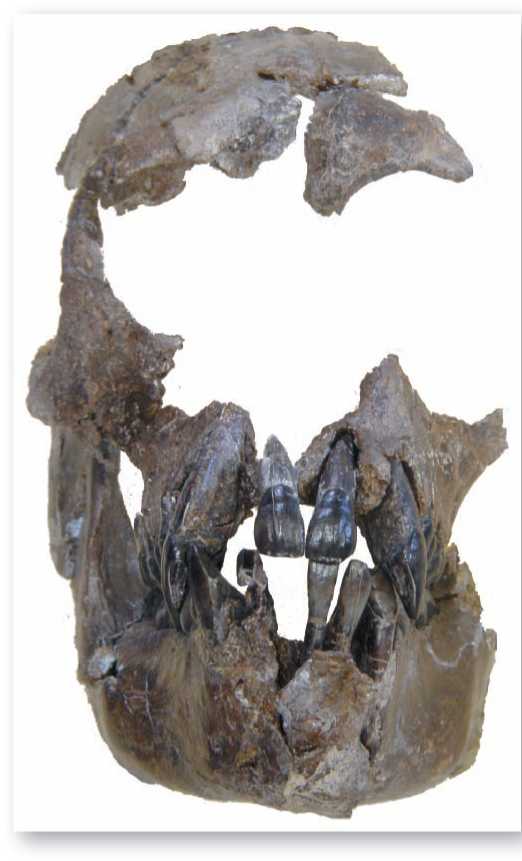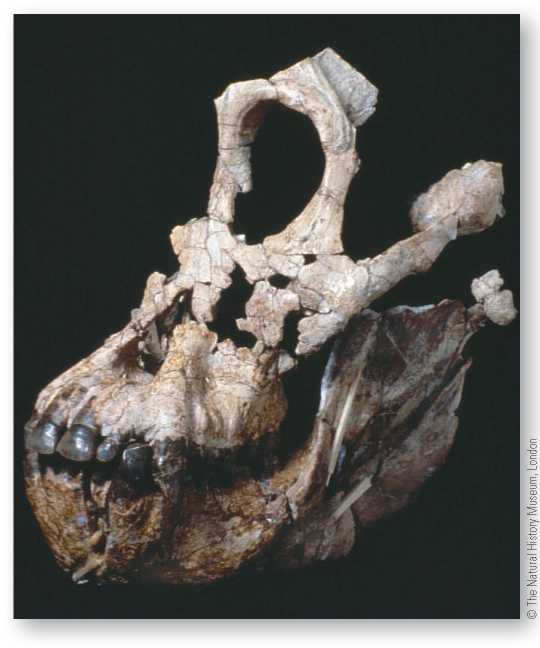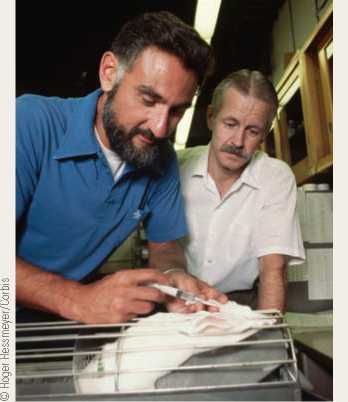True apes first appeared in the fossil record during the Miocene epoch, 5 to 23 mya. It was also during this time period that the African and Eurasian landmasses made direct contact. For most of the preceding 100 million years, the Tethys Sea—a continuous body of water that joined what are now the Mediterranean and Black Seas to the Indian Ocean—created a barrier to migration between Africa and
Eurasia. Once joined through the region of what is now the Middle East and Gibraltar, Old World primates, such as the apes, could extend their range from Africa into Eurasia. Miocene ape fossil remains have been found everywhere from the caves of China, to the forests of France, to East Africa, where scientists have recovered the oldest fossil remains of bipeds.
So varied and ubiquitous were the fossil apes of this period that the Miocene has even been labeled by some as the “golden age of the hominoids.” The word hominoid comes from the Latin roots homo and homin (meaning “human being”) and the suffix oides (“resembling”). As a group, the hominoids get their name from their resemblance to humans.
In addition to the Old World anthropoid dental formula of 2-1-2-3 and Y5 molars, hominoids can be characterized by the derived characteristics of Y5 molars, having no tail, and having broad flexible shoulder joints. As described in Chapters 3 and 4, the likeness between humans and the other apes bespeaks an important evolutionary relationship that makes other living hominoids vulnerable to human needs in today’s world. In the distant past, one of the Miocene apes is the direct ancestor of the human line. Exactly which one is a question still to be resolved.
An examination of the history of the contenders for direct human ancestor among the Miocene apes demonstrates how reconstruction of evolutionary relationships draws on much more than simply bones. Scientists interpret fossil finds by drawing on existing beliefs and knowledge. With new discoveries, interpretations change.
The first Miocene ape fossil remains were found in Africa in the 1930s and 1940s by the British archaeologist A. T. Hopwood and the renowned Kenyan paleoanthro-pologist Louis Leakey. These fossils turned up on one of the many islands in Lake Victoria, the 27,000-square-mile lake where Kenya, Tanzania, and Uganda meet. Impressed with the chimplike appearance of these fossil remains, Hopwood suggested that the new species be named Proconsul, combining the Latin root for “before” (pro) with the stage name of a chimpanzee who was performing in London at the time.
Dated to the early Miocene 17 to 21 million years ago, Proconsul has some of the classic hominoid features, lacking a tail and having the characteristic pattern of Y5 grooves in the lower molar teeth. However, the adaptations of the upper body seen in later apes (including humans) were absent. These included a skeletal structure adapted for hanging suspended below tree branches. In other words, Proconsul had some apelike features as well as some features of four-footed Old World monkeys (Figure 6.7). This mixture of ape and monkey features makes Proconsul a contender for a missing link between monkeys and apes but not as a connection between Miocene apes and later-appearing bipeds.
At least seven fossil hominoid groups besides Proconsul have been found in East Africa from the early to middle Miocene. But between 5 and 14 mya this fossil record thins out. It is not that all the apes suddenly moved from

Figure 6.7 Reconstructed skeleton of Proconsul. Note the apelike absence of a tail but monkeylike limb and body proportions. Proconsul, however, was capable of greater rotation of forelimbs than monkeys.
Africa to Eurasia, but that the environmental conditions made it less likely that any of the African remains would fossilize. Tropical forests inhabited by chimps and gorillas today constitute unfavorable conditions for the preservation of bones. As mentioned in Chapter 5, in order to become a fossil, bones must be quickly incorporated into the earth before any rotting or decomposition occurs. In tropical forests, the heat, humidity, and general abundance of life make this unlikely. The bones’ organic matrix is consumed by other creatures before it can be fossilized.
Nevertheless, the scarcity of African fossil evidence from this time period fits well with notions about human origins that prevailed in the past. Two factors conspired to take the focus away from Africa. First, investigators initially did not consider that humans were any more closely related to the African apes than they were to the other intelligent great ape—the Asian orangutan. Chimps, bonobos, gorillas, and orangutans were thought to be more closely related to one another than any of them were to humans. The construction of evolutionary relationships still relied upon visual similarities among species, much as it did in the mid-1700s when Linnaeus developed the taxonomic scheme that grouped humans with other primates. Chimps, bonobos, gorillas, and orangutans all possess the same basic body plan, adapted to hanging by their arms from branches or knuckle-walking on the ground. Humans and their ancestors had an altogether different form of locomotion: walking upright on two legs. On an anatomical basis, the first Miocene ape to become bipedal could have come from any part of the vast Old World range of the Miocene apes.
The second factor drawing attention away from African origins was more subtle; it was not embedded in the bones from the earth but in the subconscious minds of the scientists: It was hard for these Eurocentric researchers to imagine

For many years paleoanthropologists considered the European wood ape Dryopithecus to be an important ancestor to humans. Fossil remains had been discovered in Europe as early as the 1850s. Eurocentrism allowed researchers to emphasize the European fossil record and to explain away the evidence from Africa.
That humans originated entirely in Africa. European scientists in the early 20th century therefore concentrated on the various species of European ape—all members of the genus Dryopithecus (pronounced “dry-o-pith-ee-kus”). They believed that humans evolved where “civilization” developed and that these apes could be the missing link to humans.
As we will see in the next chapter, it took many years for the first bipedal fossils discovered in South Africa in the 1920s to be accepted by the scientific community as key evidence of the human line. Instead, human origins were imagined to involve a close link between those who invented the first tools and those responsible for Western civilization.
During the 1960s, it appeared as though this Miocene human ancestor lived in the Siwaliks, the foothills of the majestic Himalayan Mountains along the northern borders of India and Pakistan, near the ruins of the later Indus Valley civilization. The Himalayas are some of the youngest mountains of the world. They began forming during the Miocene when the Indian subcontinent collided with the rest of Eurasia, and they have been becoming taller ever since.
In honor of the Hindu religion practiced in the region where the fossils were found, the contender was given the name Ramapithecus, after the Indian deity Rama and the Greek word for “ape,” pithekos. Rama is the physical embodiment, or incarnation, of the major Hindu god Vishnu, the preserver. He is meant to portray what a perfect human can be. He is benevolent, protects the weak, and exemplifies all noble human characteristics. Features like the relative delicacy and curvature of the jaw and palate as well as thick tooth enamel led paleoanthropologists David Pilbeam and Elwyn Simons to suggest that this was the first hominoid to become part of the direct human line. They suggested that Ramapithecus was a bipedal tool user—the earliest human ancestor. With these qualities, Ramapithecus was perfectly named.
Other Miocene apes were also present in the foothills of the Himalayas. Sivapithecus was named after the Hindu deity Shiva, the god of destruction and regeneration. In the Hindu religion Lord Shiva is depicted as an asocial hermit who, when provoked, reduces his enemies to smoldering ashes in fits of rage. Though never considered a human ancestor, Sivapithecus also had the humanlike characteristic of thick molar tooth enamel (unlike the African apes but like the orangutans). Sivapithecus also had large projecting canine teeth more suitable to a destroyer than to a human ancestor. The Sivapithecus and Ramapithecus fossils were dated to between 7 and 12 mya.
The interpretation of these fossils changed with discoveries in the laboratory. By the 1970s, scientists had begun using biochemical and genetic evidence to establish evolutionary relationships among species. Vince Sarich, a biochemist at the University of California, Berkeley, was working in the laboratory of Allan Wilson (see Anthropologist of Note) and developed the revolutionary concept of a molecular clock. Such clocks help detect when the branching of related species from a common ancestor took place in the distant past.
Sarich used a molecular technique that had been around since the beginning of the 20th century: comparison of the blood proteins of living groups. He worked on serum albumin, a protein from the fluid portion of the blood (like the albumin that forms egg whites) that can be precipitated out of solution. Precipitation refers to the chemical transformation of a substance dissolved in a liquid back into its solid form. One of the forces that will cause such precipitation is contact of this protein with
Molecular clock The hypothesis that dates of divergences among related species can be calculated through an examination of the genetic mutations that have accrued since the divergence.

In the 1960s scientists identified two distinct species of Miocene ape from the foothills of the Himalayas: Sivapithecus and Ramapithecus, The smaller one, Ramapithecus, was proposed as a tool-using species ancestral to humans. Molecular investigations along with new fossil finds demonstrate that these specimens were actually the male and female of the same species and ancestral to orangutans. This well-preserved specimen from the Potwar Plateau of Pakistan proved that Sivapithecus was ancestral to the orangutan.
Antibodies directed against it. Antibodies are proteins produced by organisms as part of an immune response to an infection. The technique relies on the notion that the stronger the biochemical reaction between the protein and the antibody (the more precipitate), the closer the evolutionary relationship. The antibodies and proteins of closely related species resemble one another more than the antibodies and proteins of distant species.
Sarich made immunological comparisons between a variety of species and suggested that he could establish dates for evolutionary events by calculating a molecular rate of change over time. By assuming a constant rate of change in the protein structure of each species over time, Sarich used these results to predict times of divergence between related groups. Each molecular clock needs to be set, or calibrated, by the dates associated with a known event, such as the divergence between prosimian and anthropoid primates or Old World monkeys and apes, as established by absolute dating methods.
Using this technique, Sarich proposed a sequence of divergence for the living hominoids showing that human, chimp, and gorilla lines split roughly 5 mya. He boldly stated
Anthropologist of Note
Though a biochemist by training, New Zealander Allan Wilson has made key contributions to anthropology through his pioneering work in applying the principles of biochemistry to human evolutionary questions. Wilson forged

Allan Wilson (right) observes as a laboratory rabbit is injected.
A new "hybrid science,” combining fossil and molecular evidence with groundbreaking results. Because the molecular evidence required rethinking long-held theories about the relationships among fossil groups, Wilson's work has been surrounded by controversy. According to those close to Wilson, he enjoyed his role as an outsider—being on the edges of anthropology and shaking things up.
Wilson was born in Ngaruwahia,
New Zealand, and grew up on a farm in Pukekohe. After attending school in New Zealand and Australia, he was invited to study biochemistry at the University of California, Berkeley, in 1955. His father was reluctant to have his son travel so far from home, but his mother saw this as an opportunity for him and encouraged him to head to California.
Wilson stayed at Berkeley for the next thirty-five years, running one of the world's most creative biochemistry labs. In the 1960s, Berkeley was a center of academic liberalism and social protest. Wilson's highly original work was conducted with a similar revolutionary spirit, garnering him a MacArthur "genius”
Award, two Guggenheim fellowships, and a place on the short list for the Nobel Prize.
He developed the notion of a "molecular clock” with his graduate student Vince Sarich and published the groundbreaking paper "Immunological Time-Scale for Human Evolution” in the journal Science in 1967. The molecular clock proposes that evolutionary events such as the split between humans and apes can be dated through an examination of the number of genetic mutations that accumulated since two species diverged from a common ancestor. In the 1980s, his laboratory (including Rebecca Cann and Mark Stoneking) was also responsible for seminal work with the mitochondrial Eve hypothesis that continues to be widely debated today (see Chapters 8 and 9).
Wilson died from leukemia at the age of 56. Joseph Felsenstein, one of his biographers, stated in his obituary in the journal Nature, "while others concentrated on what evolution could tell them about molecules, Wilson always looked for ways that molecules could say something about evolution.”
That it was impossible to have a separate human line before 7 mya “no matter what it looked like.” In other words, anything that old would also have to be ancestral to chimps and gorillas as well as humans. Because Ramapithecus, even with its humanlike jaws, was dated to between 7 and 12 mya, it could no longer be considered a human ancestor.
In the meantime, Pilbeam continued fossil hunting in the Himalayan foothills. Further specimens began to indicate that Ramapithecus was actually a smaller, perhaps female version of Sivapithecus.15 Eventually all the specimens referred to as Ramapithecus were “sunk” or absorbed into the Sivapithecus group, so that today Ramapithecus no longer exists as a valid name for a Miocene ape. Instead of two distinct groups, one of which went on to evolve into humans, they are considered males and females of the sexually dimorphic genus Sivapithecus. Pilbeam found a spectacular complete specimen in the Potwar Plateau of Pakistan, showing that Sivapithecus was undoubtedly the ancestor of orangutans. This conclusion matched well with the molecular evidence that the separate line to orangutans originated 10 to 12 mya.
All of these changes reflect the fact that paleoan-thropologists participate in an unusual kind of science. Paleoanthropology, like all paleontology, is a science of discovery. As new fossil discoveries come to light, interpretations inevitably change, making for better understanding of our evolutionary history. Today, discoveries can occur in the laboratory as easily as on the site of an excavation. Molecular studies since the 1970s provide a new line of evidence much the same way that fossils provide new data as they are unearthed. A discovery in the laboratory, like molecular clocks (now calibrating the split between 5 and 8 mya), can drastically change the interpretation of the fossil evidence.
The converse is also true. Fossil discoveries can raise new interpretations of the course of evolutionary history. The discovery of a 10-million-year-old ape in Ethiopia in 2007, thought to be ancestral to gorillas, provides a case in point.85 Genetic evidence had pointed to a split between humans and the other African apes sometime between 5 and 8 mya. The scientists who found the nine fossil teeth that resulted in the naming of the species claim
15 Pilbeam, D. R. (1987). Rethinking human origins. In R. L. Ciochon & J. G. Fleagle (Eds.), Primate evolution and human origins (p. 217). Hawthorne, NY: Aldine.
That it indicates that the gorilla lineage had become distinct 2 to 4 million years earlier than that. The species is called Chororapithecus abyssinicus, after Chorora, the local area where the fossil was found, and Abyssinia, the ancient name of Ethiopia. While Ethiopia has been the home for numerous spectacular fossil specimens that are part of the human lineage, this is the first fossil ape discovery from this region. Other scientists do not concur, however, and feel more fossil evidence is warranted before pushing back the timing of the split.




 World History
World History









